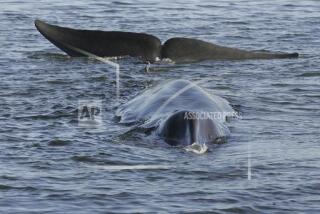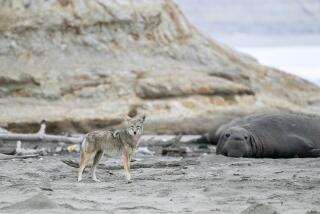Hunters Plot but Tourists May Save Canada Seals
- Share via
TORONTO — Canadian harp seals may soon return as an industry, but one that will likely draw praise, not protests, from environmentalists who have fought the slaughter of the appealing animals by club-wielding hunters.
The new industry? Tourism.
Eugene Lewis, a professor of electrical engineering at the University of New Brunswick, took 160 tourists by helicopter to visit the seal herds off Prince Edward Island.
“The response,” he said, “has been absolutely overwhelming.” Some enthusiastic visitors paid for as many as four separate trips.
He said he expects to attract about 500 people to see the seals next year, even at a price of about $300 to spend two hours in a helicopter and one hour on an ice floe watching seals. Eventually, up to 2,000 tourists a year might take part, Lewis said.
The professor said it took him two years to get permission from government authorities, who suspected his operation of being “a front for the protest movement.”
The process was eased when the incumbent Liberal government, which strongly supported the seal hunt, was defeated last fall by the Progressive Conservatives.
“We have worked out careful procedures to make sure we are not interfering with what’s going on out there, whether it’s hunting or natural processes,” Lewis said.
The hunting, which once took hundreds of thousands of seals each year, has been beaten back to a local operation. This year, about 2,000 seals were killed around the Magdalen Islands in the Gulf of St. Lawrence, while another 10,000 have been slaughtered the northeastern coast of Newfoundland.
“Based on the hunt take in 1985, we have a victory,” said Alan Reichman, an official of Greenpeace, one of the environmental groups that have campaigned against the seal hunt.
“But we have to be on guard. There certainly is a possibility that the Canadian Sealers Assn., even with the help of the Canadian government, could establish new markets. We’re going to have to get going and work hard so they don’t find those markets.”
And, in fact, Canadian sealers are working to do just that.
“We can’t go any lower than we’ve gone,” said Mark Small, president of the Canadian Sealers Assn.
There is no market at all for seal pelts this year, he said, and local sales of seal meat and blubber do not bring in enough money to support a large-scale hunt.
However, Small said he and other seal hunters think they can overcome the international outcry.
“Within two or three years we could have a pretty good sealing industry here in Canada,” Small said. “We have markets for all the meat we can produce. We have markets for the seal oil,” he said. “We have tested the leather market and it looks like by next year we could be selling into that market.”
The next step, Small said, is to have the seal pelts tanned and made into clothing to be sold in Asia, where concern for wildlife is generally much lower.
In the past, dating back hundreds of years, nearly all Canadian seal pelts have been sold in their raw form for export to Europe for processing and marketing. Now, however, Canadian seal imports are banned by the United States and the 10-nation European Common Market, where photographs of the gory slaughter, accompanied by images of the doe-eyed and helpless harp seal pups,aroused intense opposition to the hunt.
Small said that he doesn’t expect as much trouble from protests as in the past, because the revived hunt will focus on adolescent and adult seals, rather than the pups.
However, Reichman of Greenpeace said, “We’re opposed to commercial sealing, whether cute baby seals or adults are taken.”
More to Read
Sign up for Essential California
The most important California stories and recommendations in your inbox every morning.
You may occasionally receive promotional content from the Los Angeles Times.













